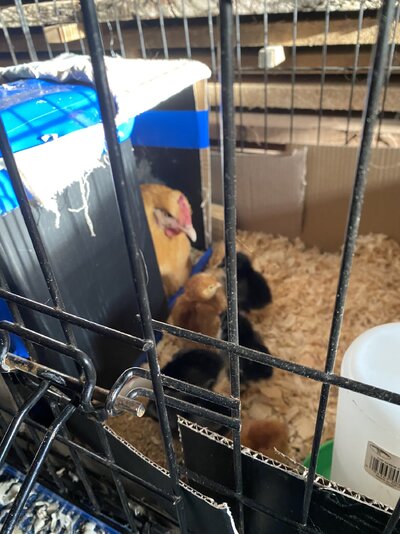fmorlando1
Chirping
- Jun 29, 2021
- 37
- 47
- 96
Most of my flock are Buff Orpingtons as is my only rooster. I want to diversify my flock and have an order of 6 chicks scheduled to arrive from the hatchery tomorrow morning. My intent was to put them in a brooder but since I put in the order in I now have a broody hen. I think she has been broody for about a week and a half to 2 weeks, I tried breaking her by quickly removing all eggs and moving her out of the nest box but she would immediately return I even caught her moving eggs from other boxes to hers. When those were taken away she would still sit without any eggs. Since I have the new chicks coming in I've decided to try to see if I can get to to adopt them. 5 days ago I gave her 2 fake eggs and 2 real eggs and moved her into a private box out of the coop and away from the other chickens in the garage. I have yet to see her leave her new nest. From what I have read there would be a better chance of a successful adoption if she had been sitting for a longer period of time but the chicks were already scheduled to arrive tomorrow so I'm going to give it a shot.
I've also read you can have more success putting the chicks under her at night but since they will arrive early tomorrow morning I would like to get them under her as quickly as possible. So I'm going to black out the windows of the garage to simulate night and put them under her right away and remove her eggs. I figure this way I can also sneak in and monitor if she is accepting them. If she doesn't accept them I will be ready to move them into a brooder. If she doesn't accept them and I have removed her eggs will she stay broody? And if so should I give her her eggs back. I would hate to try and break her after she has been sitting. She seems very committed to being a mother. Any thoughts, additional tips or flaws in my plan?
I've also read you can have more success putting the chicks under her at night but since they will arrive early tomorrow morning I would like to get them under her as quickly as possible. So I'm going to black out the windows of the garage to simulate night and put them under her right away and remove her eggs. I figure this way I can also sneak in and monitor if she is accepting them. If she doesn't accept them I will be ready to move them into a brooder. If she doesn't accept them and I have removed her eggs will she stay broody? And if so should I give her her eggs back. I would hate to try and break her after she has been sitting. She seems very committed to being a mother. Any thoughts, additional tips or flaws in my plan?


